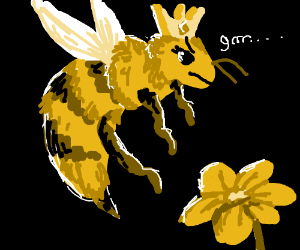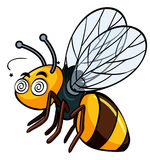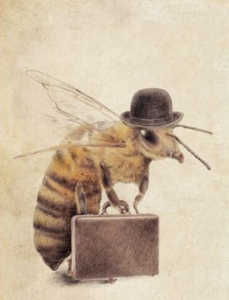As I was already cautioned: anthropomorphism is strongly not recommended when observing mother nature but while the polyandrous system of A. mellifera is interesting I do think the male gets the short end of the stick. Course spiders eat their mates and all that, but this post is merely for fun. There is a kamikaze element to the order Insectivora that is interesting and totally foreign to most mammalian patterns of mating. 
Queens mate with at least 10 to 20 drones in the drone congregating area and can mate with even more. Later the queen mixes up the semen collected and discards about 90 percent. The rest will remain stored and viable in a slow release form for up to three years. She retains the sperm diversity of ALL the males she has had congress with.
So I had the following questions? Especially after watching the TWO very, very different videos.
Picture the male bee as he’s falling to his death: “It was worth iiiiitttttttttttttt…”
2. Or this much more reasonable species. Bees getting it on. Long horned bees having sex.
Many insect males die after mating, but other bee species like the Bumblebee are not that cruel. A bumblebee males can mate up to ten times in the lab.
So in the honey bee scenario and mating flight is their real competition or selection by her during flight, or is it simply the first guy in the gate? Unlike birds and other species there does not seem to be much competition between males. I imagine them winging each other offside, but that is not the case.
Or do some of them being aware of the self-sacrifice after losing their ‘package’ opt to fly a bit more slowly and return to the hive after having done the chase. The guy who wants to live the full 90 days! 
That suggests that just maybe some survival instance might make a drone do a polite decline. Or will he be like the 99 percent of the fellow kamikaze males mate knowing that their testicles will explode, and they will die.
Why has this species evolved this way? No ‘Safe Sex, or foreplay at least?
Instead, it seems that the path is more like the Santa Anita racetrack, during the queen’s nuptial flight, she’ll mate with about a dozen partners and leave a trail of their dead, penis-less corpses in her wake.

There are no PETA outcries for this outrage and as a male I was going to make another comment but this one made my penis explode. Most insultingly, is the fact that every male after the former has to remove the last guys parts to begin mating. Just like my ex-wife.
Sue Colby from WSU got my mind percolating on this subject, but I did not take notes. I do however remember and noted the familiar lift off times for males heading off into the wild blue yonder. Come warm Spring weather, about 12:00 one could observe the males waiting like fighter pilots on the landing deck just waiting for their opportunity to soar to what hopefully will be their oblivion.
Leaving the hive on warm afternoons = lusting off for queens.
How twisted is that and what did these poor males do in their former life to deserve this Buddhist rebirth as a drone honey bee? FACT: When a drone mates with a queen and releases his semen, it happens with such a force that his endophallus is ripped from his abdomen. When his abdomen rips open he usually dies shortly after.
Mind you, bees are not the only animals that face this scenario while having sex. The male wasp spider also loses his testicles during sex for the same reason as the bee. Other insect females eat the male when they are done with him.
Insects are very puzzling creatures and with the honey bee, consensus is the operating word. So if a shirker, ‘that drone’ who opts to ejaculate not for the greater good, returns to the hive, what becomes of him? A Shunning?
“To mate or not to mate?” is the existential question and most drones, will faithfully do their Darwinian thing … what they were programmed by evolution to do.
Perhaps it is all about pheromones and these guys are drugged. Or is it that if you figure your only going to live for 90 days anyway, why pass up the chance of having sex with a hot queen bee? Your mellifluous version of a Nicole Kidman.
To throw in more anthropomorphic envy. Queen bees really get around.
FACT: Queen bees generally mate with at least 10 to 20 drones and can mate with even more on one sex crazed flight. Awesome statistic to think about. Same for this: Once the special structure inside her abdomen (spermatheca) is full – she will never mate again. Later the queen mixes up the semen collected and discards about 90 percent. The rest will remain stored and active for up to three years and retains the sperm diversity of ALL the males she has had congress with.
FACT: The queen, will store the sperm for use throughout her life. “The queen can store 6 million sperm and keep them viable for up to seven years, with the potential of producing 1.7 million offspring during her lifetime, as she uses a few at a time to fertilize her eggs.”
Now the question remains: Why does the European honey bee queen leave with the prime swarm while other species do it the other way around? The mother queen stays home and keeps maintaining the source nest and as with humans sends the kids out to expand the nests future. To be answered in COMMENTS.
Awesome pictures of other bee species. A MUST VISIT
Final comment on the poor drone!
Kicked Out of the Hive.
It’s bad enough to die because of sex, but this is not all. Every fall, when the incoming nectar flow becomes scares, drones just become another mouth to feed. Forgotten, the times they warmed the brood and Chippendaled the worker bees to greater effort.
It’s time for pre-winter rent evictions. Without mercy to their brothers, the worker bees decide to kick the drones out. There is no leniency, no rent controls. The workers first refuse to feed the drones, thereby weakening the guys, then escort them to the entrance and give them a kick. Hypothermia or starvation is their final reward.
Mind you, beekeepers also give them the green frame treatment. We encourage the queen to build up their numbers only to stick them in the freezer for mite control.
Polyamorously yours

QUESTION: Why does the European honey bee queen leave with the prime swarm while many other species do it the other way around? The mother queen stays home and keeps maintains the source nest. Stingless bees are one such example. Bumblebees also do this far more intelligently.
As with the honeybee, the queen bumble also raises tons of worker brood as needed, but by the end of summer, she begins to think of the hives future. Only then does she start laying unfertilized eggs which become drones. Neither is she inclined to be regicidal, allowing some of her female offspring to become new, fertile queens.
She also realizes that unlike Queen Elizabeth it is time to die and let the new gal take over. Her work is done and she dies. In Fall, the queens and males mate (same sad ending for the males) but as I understand it, the queens stays in the nest to overwinter and then venture out the next spring to begin new colonies.
With new queens ready to continue the genetic line, the old bumblebee queen dies, her work is complete. In the Fall, the new queens and males mate. The males also die after mating and the new generations of bumblebee queens seek shelter together for the winter and wait until the following spring to begin new colonies.
HONEYBEES have a totally different approach. First, we have the strange task of personal trainers … the workers task of thinning down the fat old queen** and gambling on that girl to fly the distance. Territorial y speaking, struggling out to find a nearby working home does not make much sense. Certainly not to the point of emptying out the nest with 50 percent of the gals and HOPING the left behind virgin queen and princesses in waiting step up to the fertilization plate
1. That old queen and entourage have a limited future (egg laying wise) at best.
2. The replacement queen (yet needing to mate) may be eaten by a black hornet, bird or simply fail to mate because of weather. All a gamble and certainly not a winning way to expand territory or a good example of reproductive survival.
I have no clue as to the why of this. The (old queen) stay at home approach, letting the stronger flying children find their new homes seems far better if you ask me.
Fun question. Why questions are the best.
Or better yet, why only (normally) one queen? Ants for example (relatives of bees and wasps), may have several hundred queens in colonies that can spread out over acres comprising hundreds of thousands of workers. Obviously an enormously successful strategy. The superorganism works this way because it works. But in a small cavity space, such as a tree where honey bees live, there isn’t enough space for multiple queens.
One hypothesis has it that since honey bees are denizens of relatively small cavity spaces (ideally preferring about 40 liters), and since a queen honey bee is the sole source of the genetics for her offspring, any reproductive competition is eliminated in order to maintain the colony’s stability, i.e.,her suite of queen pheromones are selected to continually signal her presence until she reaches old age (supercedure) or the cavity space becomes very crowded (a necessary condition for colony reproduction).
The problem being, in the run up to colony reproduction (swarming), there can be multiple reproductives developing in order to pull the whole thing off. Generally, the first unmated queen to emerge, will likewise set up to also eliminate her reproductive competition. (Prior to mating). This could be her developing sisters as well as her mother, the old queen. So it turns out, there’s a slightly better chance of the colony successfully reproducing if the mother queen leaves with her cohort of wax builders a few days prior to these new queen(s) (unmated killing machines) emerging!
Even though it’s all highly structured, I think it’s always important to keep in mind that the blind watch maker of natural selection does not have a “plan”. It’s risky, but this behavior operates because it works. I don’t think it’s really valid to say it’s better or worse than some other taxa’s method. As you know, there’s almost nothing that’s “the normal way” for honey bees. Pretty much everything they do is quite abnormal compared to the other 20,000 species of bees… it evidently does work pretty well for them considering honey bees occupy pretty much everywhere except Antarctica and the North Pole.